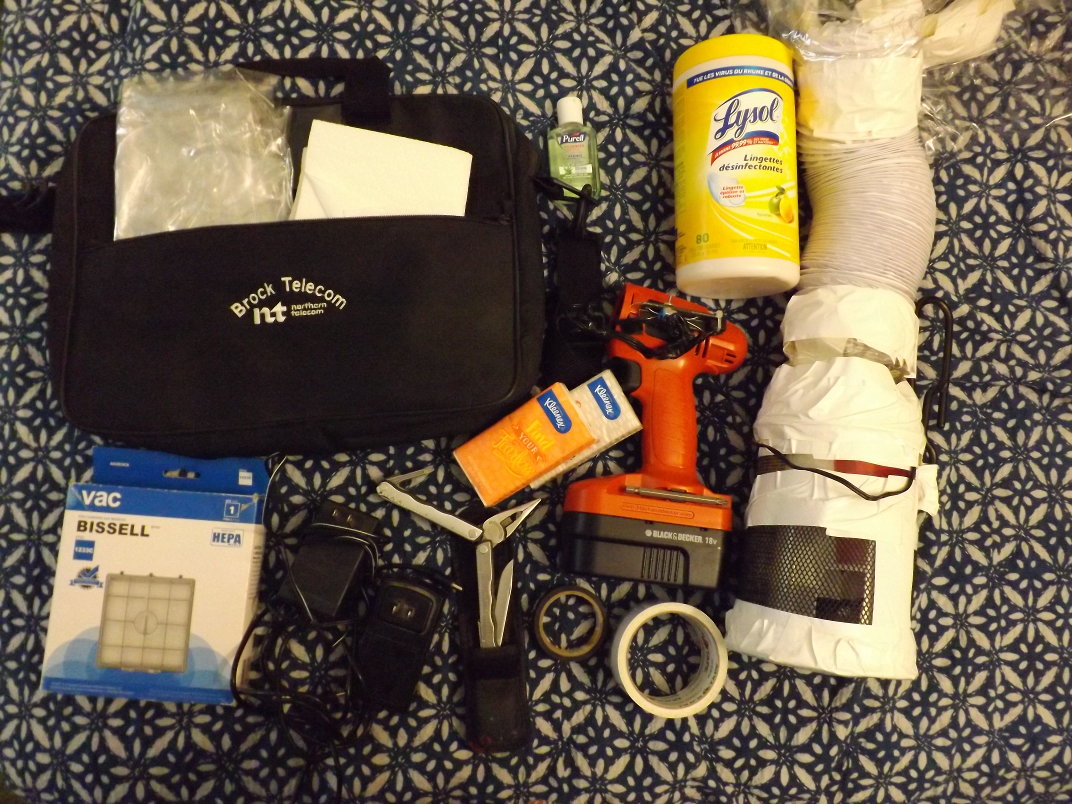Maker Darrel Johnson has constructed his own biohazard gear from a vacuum cleaner’s HEPA filter, a vinyl duct hose, a blow dryer fan, a clear plastic tablecloth, and duct tape. He believes this powered respirator will help himself and others navigate public spaces without fear of contracting the coronavirus.
“I'm not an expert, and can't guarantee that anything here will work,” he said on a website explaining the project. “I'm hoping that my effort will start a conversation and attract more relevant experts and people with hands-on fabrication skills to quickly produce the guide that this is a rough start on.”
Johnson’s invention is a DIY Powered Air-Purifying Respirator (PAPR), a device that lets him breathe air in public without worrying about contamination from disease. Wearing one is like walking around with an air purifier strapped to your body. PAPRs are common in places like biolabs, but rare in public. The idea is to surround the body in a controlled environment and filter the air as it enters the body.
The most disease-conscious among us get away with wearing masks and gloves, even during a pandemic, but Johnson believes his machine or one like it could help people navigate the world in safety.
“I've worn it for hours at a time in my apartment, to be confident that it's safe and comfortable, but I haven't had any pressing reason to break isolation, so I haven't gone anywhere in it,” Johnson told Motherboard in an email.

Johnson got the idea for the machine when he saw news footage of people in China attempting to improvise PPE. “I saw a man walking around with a clear garbage bag over his head, down to his knees, to supplement his surgical mask, and my thought was ‘He could probably have made something better for himself than that even under those conditions,’” Johnson said. “And I took a crack at it. I hoped to demonstrate something other people could easily build for themselves and for those around them, in China and if it spread elsewhere.”
Before this, he was working on something he called the “Space Development Club,” a plan to “make outer space fit for ordinary people to live, work, and play.”
He read up on biohazard gear and PAPRs and decided to try to build something using what he had on hand. “When I looked around my own apartment, I had various sorts of fans, batteries, and filters, including a HEPA filter in my vacuum cleaner, which is the same type of
filter as are used in medical PAPRs,” Johnson said. “While not everyone can find a HEPA filter or a cordless drill in their home, they are common and inexpensive, produced in huge quantities for the consumer market, so I think there's enough.”
He’s not alone. People are already making their own PPE and medical professionals are trading information online about how to build and maintain protective gear. Homemade PAPR is just the next level, and there’s several people online building their own. “They all seem to be using some variation on a scuba mask design with 3d printed parts,” Johnson said.
There are disadvantages to the PAPR system. They’re harder to build, heavy, require a power source, and aren’t comfortable.
“I don't think PAPRs for common individual use would be overkill, especially when there's so much that isn't known about the virus,” Johnson said. “It's brutally hard to stop a highly contagious disease from spreading, and there's a lot of work that needs to be done in shared spaces with other people, so we should apply the strongest tools we reasonably can to the problem.”
Johnson is still tweaking his DIY PAPR project, trying to make it cheaper and more efficient. His current system uses a battery pack which only runs an hour, but can be plugged into a wall to keep it going. He’s looking for help from makers to innovate and iterate.
“Most of the small amount of feedback I've received has been positive (of course, if you post a picture of yourself with a duct-taped plastic bag over your head, you get a few people who think you're crazy and tell you so), but I've been disappointed by the lack of others making an actual hands-on attempt,” he said.
People can help Johnson out by following him on Twitter and checking out his website.
from VICE https://ift.tt/3cQfrom
via cheap web hosting
No comments:
Post a Comment